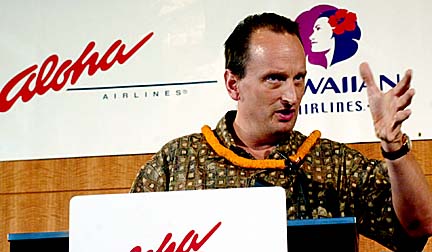


|
Air merger to save Combining Hawaiian and Aloha airlines should cut expenses by $90 million a year, with results showing by the end of this year, according to a disclosure statement filed with the federal government Thursday.
$90 million annually
The marriage of Hawaiian and Aloha
airlines will become profitable
"over time," a report saysBy Russ Lynch
rlynch@starbulletin.comThe document, prepared by airline businessman Greg Brenneman's business TurnWorks with the cooperation and support of Hawaiian and Aloha, says that putting the two together, cutting flights that compete head-to-head at certain times of the day and combining both fleets of aircraft will save money.
There are other changes, too, that would radically alter the structure of Hawaii aviation and, according to TurnWorks, increase the combined airlines' revenues by 5 percent to 10 percent a year during the first five years of the merger and turn operating losses into a 9 percent to 20 percent profit margin "over time."
One of the proposals calls for making the combined fleet more modern and less complicated, with fewer aircraft types than the two fleets now have. Brenneman has previously said he likes Hawaiian's new Boeing 717s for interisland routes and may buy more of them.
Brenneman, a former president of Continental Airlines who at age 40 has decided to take on the Hawaii challenge, said in the document he plans to reduce the number of interisland flights by 10 percent to 12 percent "without compromising the needs and convenience of its passengers."
The load factor, which is the percentage of available seats filled by paying passengers, should not exceed 80 percent on any interisland flight, but that level will be profitable while the current lower levels are not, the document said.
One big planned shift is the recognition that it may be a bad business idea to rely heavily on interisland service, which has been attacked in recent years by direct flights from the mainland to neighbor island airports.
The document says the new airline, which has not been given a name, would have a goal of generating two-thirds of its revenues from long-haul flights outside Hawaii and one-third from interisland service.
The document sets out to show that interisland passenger service is not profitable for either of the two local airlines.
Separating out unusual items and concentrating on the day-to-day operations, the document says Aloha has not broken even on interisland flights since 1998.
Aloha did not start flying to the mainland until early 2000. Hawaiian, which has had mainland flights since 1984, did not separate out its interisland and mainland services in the document for earlier periods but the post-Sept. 11 numbers make it clear that there are losses on interisland routes.
For the last three months of 2001, Aloha needed its planes to be 84 percent full in order to meet the operating costs of the flights, the merger document says. In that low period after the terrorist attacks, Aloha had an interisland load factor averaging 67 percent, well below break-even.
In those post-disaster months, Hawaiian needed a 76 percent load factor to break even but experienced only a 64.7 percent load.
While there is no direct comparison available for earlier periods with Hawaiian, whose financial reports bundle together interisland, mainland-Hawaii and Hawaii-South Pacific numbers, the document shows a small but steady difference between the load factor Aloha needed to generate and what it actually achieved in 1999, 2000 and the first nine months of 2001.
The Sept. 11 attacks also dramatically increased the amount both airlines must spend on insurance. Hawaiian's insurance costs increased 244.4 percent, to $12.4 million. Aloha's cost jumped 140.4 percent to $12.5 million.
Those are just a few of the items of information in what must be a bewildering document to many.
Even the number of pages is hard to figure because printed copies are not yet available and it has to be scrolled through on a computer screen.
Including all the attachments, such as copies of aircraft lease agreements, it appears to run to more than 500 pages.
For those who don't want to wait and can take the time to look at it on the Internet, it can be viewed at http://sec.freeedgar.com/displayText.asp?ID=1765689.